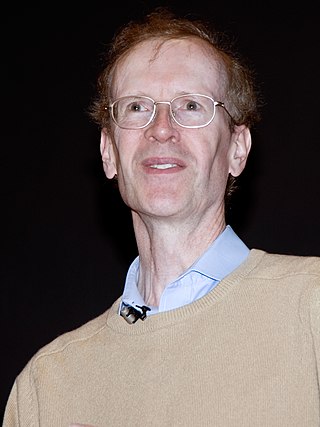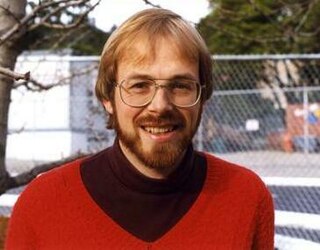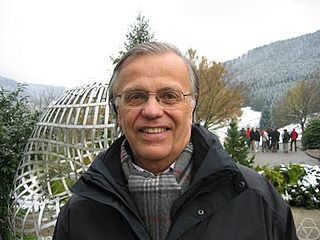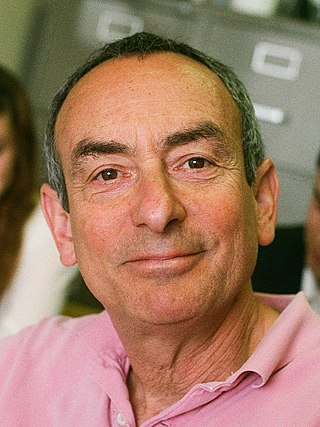
Sir Andrew John Wiles is an English mathematician and a Royal Society Research Professor at the University of Oxford, specialising in number theory. He is best known for proving Fermat's Last Theorem, for which he was awarded the 2016 Abel Prize and the 2017 Copley Medal by the Royal Society. He was appointed Knight Commander of the Order of the British Empire in 2000, and in 2018, was appointed the first Regius Professor of Mathematics at Oxford. Wiles is also a 1997 MacArthur Fellow.

In mathematics, a conjecture is a conclusion or a proposition that is proffered on a tentative basis without proof. Some conjectures, such as the Riemann hypothesis or Fermat's Last Theorem, have shaped much of mathematical history as new areas of mathematics are developed in order to prove them.
The modularity theorem states that elliptic curves over the field of rational numbers are related to modular forms. Andrew Wiles proved the modularity theorem for semistable elliptic curves, which was enough to imply Fermat's Last Theorem. Later, a series of papers by Wiles's former students Brian Conrad, Fred Diamond and Richard Taylor, culminating in a joint paper with Christophe Breuil, extended Wiles's techniques to prove the full modularity theorem in 2001.

Richard Lawrence Taylor is a British mathematician working in the field of number theory. He is currently the Barbara Kimball Browning Professor in Humanities and Sciences at Stanford University.

Gerhard Frey is a German mathematician, known for his work in number theory. Following an original idea of Hellegouarch, he developed the notion of Frey–Hellegouarch curves, a construction of an elliptic curve from a purported solution to the Fermat equation, that is central to Wiles's proof of Fermat's Last Theorem.

Yutaka Taniyama was a Japanese mathematician known for the Taniyama–Shimura conjecture.

A modular elliptic curve is an elliptic curve E that admits a parametrisation X0(N) → E by a modular curve. This is not the same as a modular curve that happens to be an elliptic curve, something that could be called an elliptic modular curve. The modularity theorem, also known as the Taniyama–Shimura conjecture, asserts that every elliptic curve defined over the rational numbers is modular.

Pierre de Fermat was a French mathematician who is given credit for early developments that led to infinitesimal calculus, including his technique of adequality. In particular, he is recognized for his discovery of an original method of finding the greatest and the smallest ordinates of curved lines, which is analogous to that of differential calculus, then unknown, and his research into number theory. He made notable contributions to analytic geometry, probability, and optics. He is best known for his Fermat's principle for light propagation and his Fermat's Last Theorem in number theory, which he described in a note at the margin of a copy of Diophantus' Arithmetica. He was also a lawyer at the Parlement of Toulouse, France.

Paul Friedrich Wolfskehl, was a physician with an interest in mathematics. He bequeathed 100,000 marks to the first person to prove Fermat's Last Theorem.
The problem in number theory known as "Fermat's Last Theorem" has repeatedly received attention in fiction and popular culture. It was proved by Andrew Wiles in 1994.

In number theory, Fermat's Last Theorem states that no three positive integers a, b, and c satisfy the equation an + bn = cn for any integer value of n greater than 2. The cases n = 1 and n = 2 have been known since antiquity to have infinitely many solutions.
Chike Obi was a Nigerian politician, mathematician and professor.

Wiles's proof of Fermat's Last Theorem is a proof by British mathematician Andrew Wiles of a special case of the modularity theorem for elliptic curves. Together with Ribet's theorem, it provides a proof for Fermat's Last Theorem. Both Fermat's Last Theorem and the modularity theorem were almost universally considered inaccessible to proof by contemporaneous mathematicians, meaning that they were believed to be impossible to prove using current knowledge.
Fermat's Last Theorem is a theorem in number theory, originally stated by Pierre de Fermat in 1637 and proven by Andrew Wiles in 1995. The statement of the theorem involves an integer exponent n larger than 2. In the centuries following the initial statement of the result and before its general proof, various proofs were devised for particular values of the exponent n. Several of these proofs are described below, including Fermat's proof in the case n = 4, which is an early example of the method of infinite descent.

Barry Charles Mazur is an American mathematician and the Gerhard Gade University Professor at Harvard University. His contributions to mathematics include his contributions to Wiles's proof of Fermat's Last Theorem in number theory, Mazur's torsion theorem in arithmetic geometry, the Mazur swindle in geometric topology, and the Mazur manifold in differential topology.
Joshua Rosenblum is an American composer, conductor, pianist, arranger, music journalist, and writer. He has composed extensively for the concert hall as well as for musical theatre, and currently teaches Composing for Musical Theater at Yale University, his alma mater, as well as Conducting at New York University. As a pianist, he has performed frequently in the New York City area as soloist and accompanist, as well as in Broadway pit orchestras, and with the New York City Center Encores! Orchestra. He has conducted numerous Broadway and Off-Broadway shows, including How the Grinch Stole Christmas!, Wonderful Town, Falsettos, Miss Saigon, and Anything Goes. Most recently he served as pianist and associate conductor for the hit 2022 Broadway revival of Stephen Sondheim and James Lapine's Into the Woods.

Fermat's Last Theorem is a popular science book (1997) by Simon Singh. It tells the story of the search for a proof of Fermat's Last Theorem, first conjectured by Pierre de Fermat in 1637, and explores how many mathematicians such as Évariste Galois had tried and failed to provide a proof for the theorem. Despite the efforts of many mathematicians, the proof would remain incomplete until 1995, with the publication of Andrew Wiles' proof of the Theorem. The book is the first mathematics book to become a Number One seller in the United Kingdom, whilst Singh's documentary The Proof, on which the book was based, won a BAFTA in 1997.

Kenneth Alan Ribet is an American mathematician working in algebraic number theory and algebraic geometry. He is known for the Herbrand–Ribet theorem and Ribet's theorem, which were key ingredients in the proof of Fermat's Last Theorem, as well as for his service as President of the American Mathematical Society from 2017 to 2019. He is currently a professor of mathematics at the University of California, Berkeley.
Fernando Quadros Gouvêa is a Brazilian number theorist and historian of mathematics who won the Lester R. Ford Award of the Mathematical Association of America (MAA) in 1995 for his exposition of Wiles's proof of Fermat's Last Theorem. He also won the Beckenbach Book Prize of the MAA in 2007 for his book with William P. Berlinghoff, Math through the Ages: A Gentle History for Teachers and Others . He is the Carter Professor of Mathematics at Colby College in Waterville, Maine.

The History of Mathematics: A Very Short Introduction is a book on the history of mathematics. Rather than giving a systematic overview of the historical development of mathematics, it provides an introduction to how the discipline of the history of mathematics is studied and researched, through a sequence of case studies in historical topics. It was written by British historian of mathematics Jackie Stedall (1950–2014), and published in 2012 as part of the Oxford University Press Very Short Introductions series of books. It has been listed as essential for mathematics libraries, and won the Neumann Prize for books on the history of mathematics.



![Pierre de Fermat, 17th century painting by Rolland Lefebvre [fr] Pierre de Fermat3.jpg](http://upload.wikimedia.org/wikipedia/commons/thumb/3/3b/Pierre_de_Fermat3.jpg/170px-Pierre_de_Fermat3.jpg)












